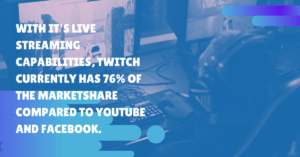Enterprise brands might think they’ve done it all online and know exactly what does and doesn’t work. However, a recent profile of a smaller skincare brand highlighted the use of multi-channel influencer campaigns that enterprise social media teams may be neglecting.
This new perspective may benefit even the most experienced social media marketing team. First, let’s dig in to what cross-channel influencer campaigns and saturation actually are, and then we’ll talk about how big brands can duplicate the results:
What is a multi-channel or cross-channel influencer campaign?
A cross-channel influencer campaign allows brands to engage social media personalities and celebrities across channels to widen their reach to more potential consumers.
With target audiences hopping across platforms and devices, it’s crucial and brands activate consumers in all the digital arenas they inhabit. By having influencers market for brands on multiple channels and beyond social media, you’re hedging your bets that more audience members will see your content and that it will be top of mind when they decide to buy.
Why is cross-channel saturation crucial?
The colloquial marketing “Rule of Seven” says that prospects have to hear or see a marketer’s message a minimum of seven times before they are inclined to buy.
Take that to the next level with today’s technology, and we can assume that consumers need to see a marketing message multiple times across channels to achieve the saturation necessary to take action.
How one skin care company grew exponentially with multi-channel influencer marketing
In a recent article on Search Engine Journal, Brad Smith wrote about how Primally Pure, a small cosmetics brand, grew exponentially with cross-channel influencer marketing. They knew that up to 92% of consumers trust individuals over brands (even if they don’t know influencers personally).

But they took it to the next level: To help incentivize their influencers, Primally Pure also created an affiliate program: “Their partners receive a cut of the revenue when their audience buys. And the affiliate program quickly made up 25% of Primally Pure’s sales.”
But they didn’t just stop there, they integrated their influencer marketing across all channels and multiple campaigns. They improved the SEO and content strategy on their own site to match with their influencer messaging and help convert their increased website traffic.
“The prospective customer … needs to recognize the value. Content is used to educate and sell that difference. High-quality blog content is used to get people to recognize the disadvantages of continuing to do something the way they’ve always done it, and how their life will measurably change when they change their decisions.”
Primally Pure ensured the written and video content on their own properties matched their social media influencer strategy. They also partnered with complementary brands for giveaways, had influencers try their own unboxing videos, encouraged customer testimonial and unboxing videos on social channels, and more.
How larger cosmetics brands can duplicate that influencer marketing success
1. Spread Your Campaign Across Multiple Owned Channels
Primally Pure took an idea for influencer marketing–and spread the campaign across all social media AND digital channels for exponential growth and ongoing campaign activation.
Think about how you can incorporate your influencer campaigns into your own site’s content and digital marketing strategy. You’ll increase traffic to your influencers’ campaigns and have message-matched assets on your own site to address the incoming traffic from the campaigns.
2. Have Your Influencer Post Content Across their Platforms
Brainstorm ways that your influencers can post content about your brand across their different platforms.
YouTube is great for reviews, makeup tutorials, unboxing, even things like ASMR (hey, W Magazine is seeing real success with it–might be worth an experimental try!). If your influencer has a blog, he or she can write a review post, host a giveaway, and more. Instagram, Facebook, and Twitter can host links to other elements of the campaign, host before and after photos.
Find ways to tie ALL these platforms together in a cohesive way to achieve message match and saturation.
3. Partner with Brands that Fit Your Target Audience
Along with creating landing pages and content relevant to their influencer campaigns, Primally Pure thought of creative, outside the box ways to partner with other relevant brands and be everywhere their target audience was online.
Think of how your target audience will use your product. Primally Pure’s skincare products are great for a #SelfCareSunday, for example. So they partnered with a wine brand, a local jeweler, and a collagen supplement company, for example.
For cosmetics brands, the right influencer marketing tools matter
Whether you’re starting a campaign from scratch or want to build on an existing influencer campaign, Sideqik has all the features that help you through the full cycle.
Discover relevant potential ambassadors. Build campaigns and engage influencers. Track activations and run giveaways. Learn more about how top brands use our comprehensive platform to scale their influencer marketing exponentially in our case studies.







